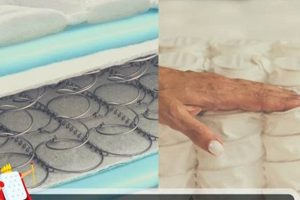The selection of appropriate bedding for memory foam mattresses, like those produced by Tempurpedic, necessitates consideration of specific characteristics. Optimal performance requires sheets that accommodate the unique properties of these mattresses, specifically their contouring and temperature sensitivity. The ideal covering should maintain the mattress’s ability to conform to the body while promoting airflow and preventing excessive heat retention.
Utilizing appropriately sized and designed sheets preserves the intended benefits of the mattress. Ill-fitting sheets can negate pressure relief and disrupt sleep. The weave, material composition, and construction all influence the sleep experience. Historical options often lacked the elasticity and breathability required, leading to discomfort. Modern advancements in textiles have addressed these concerns, providing improved comfort and temperature regulation.
The following sections will explore key attributes to consider when choosing bedding for memory foam mattresses, including material types, weave patterns, pocket depth, and specific features that enhance the overall sleep experience. Furthermore, it will delve into the implications of selecting incorrect bedding and provide actionable guidance for optimizing comfort and performance.
Tips for Selecting Optimal Bedding
Choosing bedding to complement memory foam mattresses requires careful evaluation. The following guidelines outline essential considerations for maximizing comfort and sleep quality.
Tip 1: Prioritize Material Breathability: Memory foam retains heat. Natural fibers like cotton, linen, or bamboo promote airflow, mitigating overheating and ensuring a more comfortable sleep temperature. Synthetic alternatives should be evaluated for their moisture-wicking capabilities.
Tip 2: Evaluate Weave Construction: Percale weaves offer a crisp, cool feel, while sateen weaves provide a softer, smoother texture. The weave impacts breathability and durability. Consider personal preferences and climate when making this selection.
Tip 3: Determine Appropriate Pocket Depth: Memory foam mattresses often have a substantial profile. Accurately measure mattress depth, including any toppers, to ensure a secure fit and prevent sheets from slipping off.
Tip 4: Consider Sheet Set Construction: Fully elasticized edges and reinforced seams contribute to longevity and prevent tearing. Examine the construction quality, particularly at stress points.
Tip 5: Check for Shrinkage: Pre-shrunk materials minimize size alterations after washing. Verify product descriptions and reviews to avoid unexpected shrinkage, which can compromise fit.
Tip 6: Explore Temperature-Regulating Features: Some sheets incorporate specialized materials or technologies designed to actively regulate temperature. These can be particularly beneficial for individuals prone to night sweats.
Tip 7: Review Care Instructions: Ease of maintenance impacts long-term satisfaction. Consider laundering requirements and ensure they align with personal preferences and resources.
By focusing on breathability, proper fit, and construction quality, one can enhance the sleep experience. Careful consideration of these factors will lead to a more restful and comfortable night.
The next section will delve into common mistakes to avoid when purchasing bedding for memory foam mattresses, ensuring a well-informed purchasing decision.
1. Depth
Mattress depth is a critical determinant in selecting appropriate bedding. Failure to account for mattress depth when purchasing bed sheets can result in ill-fitting covers, leading to discomfort and compromised sleep quality. Specifically, memory foam mattresses, including those manufactured by Tempurpedic, often possess a greater vertical profile than traditional innerspring mattresses due to their construction and material density. Therefore, standard-depth sheets may lack sufficient fabric to adequately encompass the mattress, leading to the sheet repeatedly detaching from the corners.
The consequence of using sheets with inadequate depth extends beyond mere inconvenience. A poorly fitted sheet can disrupt the pressure-relieving properties of memory foam, as the sheet’s tension may alter the mattress’s surface contour. This disruption can negate the intended ergonomic benefits of the mattress, potentially exacerbating pressure points and diminishing overall sleep comfort. For example, if a 14-inch deep mattress is paired with standard sheets designed for a 10-inch depth, the resulting tension on the sheet surface could reduce the mattress’s ability to conform to the sleeper’s body. Furthermore, the constant pulling and stretching of undersized sheets increase the likelihood of premature wear and tear, reducing the lifespan of the bedding.
Therefore, measuring mattress depth prior to purchasing new sheets is essential. Accurately determining the mattress’s vertical dimension ensures that the selected sheets possess sufficient pocket depth to securely and comfortably encase the entire mattress. Selecting sheets with a pocket depth that slightly exceeds the measured mattress depth is recommended to allow for ease of fitting and to accommodate any additional mattress toppers or pads. This approach will enhance comfort, preserve the mattress’s performance characteristics, and extend the lifespan of the bedding.
2. Material
The material composition of sheets significantly impacts the sleep experience, particularly when used with memory foam mattresses. Material characteristics dictate breathability, moisture-wicking properties, and overall comfort. Selection should align with individual preferences and environmental factors to optimize sleep quality.
- Cotton Varieties
Cotton, a widely used natural fiber, presents various options including Egyptian, Pima, and Upland. Egyptian and Pima cotton, known for their long fibers, produce softer and more durable sheets with enhanced breathability. Upland cotton, a more common and affordable variety, offers satisfactory performance but may exhibit less durability and breathability compared to its premium counterparts. The selection of cotton type directly influences the sheet’s texture, longevity, and ability to regulate temperature, which are crucial factors when paired with memory foam’s heat-retentive properties.
- Linen Properties
Linen, derived from flax fibers, is prized for its exceptional breathability and moisture-wicking capabilities. It promotes airflow, preventing heat buildup and maintaining a comfortable sleep environment. While initially possessing a coarser texture, linen softens with each wash, enhancing its comfort over time. Linen’s durability and resistance to pilling make it a long-lasting choice for bedding. Its ability to dissipate heat e
ffectively renders it a suitable option for memory foam mattresses, which tend to retain heat more than traditional mattresses. - Bamboo-Derived Rayon
Rayon derived from bamboo pulp exhibits softness, breathability, and moisture absorption. It drapes well and possesses a silky texture, offering a comfortable sleep surface. Bamboo rayon’s moisture-wicking properties help to regulate temperature and keep the sleeper dry throughout the night. Its hypoallergenic nature makes it suitable for individuals with sensitivities or allergies. The sustainability of bamboo as a rapidly renewable resource adds to its appeal as a bedding material. Its cooling properties particularly complement memory foam mattresses.
- Synthetic Blends
Polyester and microfiber, often blended with natural fibers, enhance durability, wrinkle resistance, and affordability. However, synthetic materials tend to be less breathable than natural fibers and may trap heat. The percentage of synthetic fibers in a blend impacts the overall performance. Higher concentrations of synthetic fibers may compromise breathability, potentially leading to discomfort. When selecting synthetic blends, prioritizing blends with a higher percentage of natural fibers is advisable to mitigate heat retention and maximize comfort.
The selection of material significantly impacts the overall performance. Breathable natural fibers like cotton, linen, or bamboo are generally more suitable for memory foam mattresses compared to synthetics. Understanding the properties of each material allows for informed decision-making, leading to an enhanced sleep experience.
3. Elasticity
Elasticity, in the context of fitted sheets for memory foam mattresses, refers to the material’s ability to stretch and recover its original shape. This property is critical for maintaining a secure fit, accommodating mattress contours, and ensuring long-term durability.
- Corner Band Elasticity
The elasticity of the bands sewn into the corners of fitted sheets directly impacts their ability to grip the mattress. Higher elasticity ensures a snug fit, preventing the sheet from slipping off, especially when the mattress is articulated, or the sleeper moves during the night. For example, sheets with low-quality, inelastic bands may detach from the mattress corner after only a few uses, necessitating frequent adjustments. In contrast, sheets with durable, high-elasticity bands maintain a secure grip, contributing to a more restful sleep.
- Material Stretch and Recovery
Beyond the corner bands, the overall fabric elasticity is vital. A sheet fabric that can stretch and conform to the curves of a memory foam mattress without permanent deformation will provide better comfort and durability. Consider a scenario where a sleeper frequently shifts positions; a sheet with poor fabric elasticity might develop permanent creases or wrinkles over time, reducing its comfort and aesthetic appeal. Conversely, a highly elastic fabric will rebound to its original form, maintaining a smooth and comfortable sleep surface.
- Thread Count and Elasticity
While thread count often correlates with softness, it doesn’t directly indicate elasticity. However, the type of weave and the materials used to create high thread count fabrics can indirectly influence elasticity. For instance, sateen weaves, despite their softness, may have less inherent elasticity than percale weaves. Additionally, the inclusion of elastic fibers, such as spandex or Lycra, in the fabric blend can significantly enhance the sheet’s overall stretch and recovery properties. This addition contributes to a more conforming and secure fit, especially beneficial for mattresses with conforming characteristics.
- Impact of Washing and Drying
The laundering process can affect the elasticity of sheet materials. High heat during washing or drying can degrade elastic fibers, leading to a loss of elasticity and a diminished fit. Therefore, it is crucial to follow the manufacturer’s care instructions to preserve the elasticity of the sheets. Air drying or using low heat settings can help to prevent premature wear and maintain the sheet’s ability to conform to the mattress. For instance, consistently using high heat settings can cause the elastic bands to weaken and lose their grip, rendering the sheets less effective in maintaining a secure fit.
These facets of elasticity collectively determine the effectiveness of fitted sheets in maintaining a secure, comfortable, and durable fit on memory foam mattresses. Sheets exhibiting superior elasticity in both the corner bands and the fabric itself will provide a more consistent and satisfying sleep experience over time.
4. Breathability
Breathability is a critical characteristic of bedding intended for use with memory foam mattresses. Memory foam’s inherent density restricts airflow, potentially leading to heat retention and discomfort. Sheet breathability directly counteracts this tendency, promoting a more regulated sleep environment. The selection of appropriate materials and weave patterns is essential to maximize breathability and optimize the user experience.
- Fiber Composition and Air Permeability
The inherent properties of different fibers dictate their air permeability. Natural fibers such as cotton, linen, and bamboo exhibit greater breathability compared to synthetic alternatives like polyester or microfiber. For instance, linen fibers possess a looser weave structure that allows for increased airflow, facilitating heat dissipation. Synthetic fibers, in contrast, tend to trap heat due to their tighter weave and lower moisture-wicking capabilities. The choice of fiber composition directly influences the sheets’ ability to mitigate heat retention, a key factor in the context of memory foam mattresses.
- Weave Pattern and Airflow
The weave pattern impacts the fabric’s texture, durability, and air permeability. Percale weaves, characterized by a plain, tight construction, offer crispness and breathability. Sateen weaves, distinguished by their silky texture and looser construction, may offer slightly less breathability compared to percale. Open weaves, such as muslin, provide exceptional airflow but may lack durability. The weave selected should balance breathability with durability to ensure long-term comfort and performance. An appropriate weave selection effectively complements the performance of memory foam mattresses.
- Moisture-Wicking Properties and Evaporation
Effective moisture-wicking properties enhance breathability by facilitating the evaporation of perspiration. Materials such as bamboo rayon and certain performance-oriented synthetic blends possess enhanced moisture-wicking capabilities, drawing moisture away from the skin and promoting evaporation. This process contributes to a cooler, drier sleep environment. Conversely, materials with poor moisture-wicking properties may trap moisture, leading to discomfort and potential skin irritation. Moisture-wicking properties directly augment breathability, essential for regulating temperature.
- Impact on Sleep Quality and Comfort
The cumulative effect of fiber composition, weave pattern, and moisture-wicking properties directly impacts sleep quality and comfort. Inadequate breathability can
lead to overheating, restlessness, and disrupted sleep. Conversely, breathable sheets promote a stable sleep environment, reducing the likelihood of temperature-related disturbances. The selection of breathable bedding can significantly enhance the sleep experience, especially when paired with memory foam mattresses prone to heat retention. Prioritizing breathability is therefore essential for optimizing sleep quality.
These facets collectively underscore the importance of breathability in bedding designed for memory foam mattresses. The interplay between fiber composition, weave pattern, and moisture-wicking properties determines the overall effectiveness of sheets in regulating temperature and promoting a comfortable sleep environment. Understanding these factors enables informed purchasing decisions and optimizes the performance and longevity of memory foam mattresses.
5. Durability
Durability, a core attribute of quality bedding, directly influences the long-term value and performance of sheets used on memory foam mattresses. The inherent properties of materials and manufacturing processes determine the lifespan of sheets. Frequent washing, friction from body movement, and interaction with the mattress itself place considerable stress on bedding. Consequently, sheets lacking robust construction or utilizing inferior materials degrade more rapidly, resulting in diminished comfort, compromised fit, and ultimately, the need for replacement. For example, low-thread-count cotton sheets may exhibit pilling and thinning after a relatively short period of use, reducing their smoothness and increasing the likelihood of tearing. The selection of durable sheets represents a more sustainable and cost-effective long-term solution.
The connection between sheet durability and the performance of a memory foam mattress extends beyond simple economics. An ill-fitting or damaged sheet can compromise the intended benefits of the mattress. Rips, tears, or significant stretching can alter the surface tension, potentially affecting the mattress’s ability to conform to the sleeper’s body and provide targeted support. Additionally, weakened seams and worn fabric may allow the transfer of body oils and perspiration into the mattress core, accelerating its degradation and fostering the growth of allergens. Therefore, investing in durable sheets contributes to both the longevity of the bedding and the hygiene and performance of the underlying mattress. Examples include sheets constructed from long-staple cotton or linen, known for their resilience, which maintain their integrity even after repeated wash cycles. Moreover, features such as reinforced seams and robust elastic bands contribute to a prolonged lifespan and a consistently secure fit.
In summary, sheet durability is not merely a desirable trait but a critical component of a well-considered bedding purchase, especially for memory foam mattresses. Durable sheets maintain their fit, comfort, and structural integrity over time, safeguarding the mattress’s performance and promoting a healthier sleep environment. The selection of high-quality materials and meticulous construction techniques yields a tangible return in terms of extended lifespan, enhanced comfort, and preservation of the mattress’s functionality. Overlooking durability can lead to premature replacement costs and a compromised sleep experience.
6. Weave
The weave pattern of bed sheets significantly influences their performance and suitability for memory foam mattresses. Different weave types offer distinct characteristics, impacting breathability, texture, and durability, all of which are crucial considerations when seeking optimal comfort and sleep quality. The interplay between weave structure and material composition determines how well a sheet interacts with the properties of a memory foam mattress.
- Percale Weave
Percale, characterized by a plain, balanced weave, offers a crisp, cool feel. This tight weave structure enhances durability and provides a smooth surface. In the context of memory foam mattresses, percale’s breathability is particularly beneficial, as it helps to mitigate the mattress’s tendency to retain heat. Percale sheets allow for greater airflow, promoting a more comfortable sleep environment. For example, individuals who experience night sweats may find percale sheets more conducive to restful sleep due to their cooling properties.
- Sateen Weave
Sateen weaves are distinguished by their silky, smooth texture and subtle sheen. The weave structure involves floating warp yarns over multiple weft yarns, resulting in a softer feel but potentially reduced breathability compared to percale. While sateen sheets offer a luxurious touch, their denser weave may trap heat against the body. Individuals sensitive to overheating may find sateen less suitable for memory foam mattresses. However, for those who prefer a warmer sleep environment, sateen provides a comfortable option. The trade-off between texture and breathability should be carefully considered.
- Twill Weave
Twill weaves are characterized by diagonal ribs or lines on the fabric’s surface. This weave structure imparts durability and wrinkle resistance. While twill sheets are less common than percale or sateen, they offer a balance between comfort and practicality. Twill’s moderate breathability makes it a viable option for memory foam mattresses in moderate climates. The diagonal weave pattern provides a unique texture and aesthetic appeal, adding a touch of sophistication to the bedding ensemble. However, twill may not be as cooling as percale or as soft as sateen.
- Jersey Knit
Jersey knit sheets, constructed using a knit rather than a woven technique, offer exceptional stretch and softness. Their flexible nature allows them to conform closely to the body, providing a comfortable, relaxed feel. Jersey knit sheets are often made from cotton or cotton blends and are known for their casual appearance. While jersey knit sheets are comfortable, their breathability may vary depending on the material composition. Some jersey knits may trap heat, while others offer adequate airflow. The suitability of jersey knit sheets for memory foam mattresses depends on the individual’s temperature preferences and the specific material blend used.
These weave types each present distinct advantages and disadvantages when paired with memory foam mattresses. Percale’s breathability, sateen’s softness, twill’s durability, and jersey’s stretchiness offer a range of options to suit individual preferences and needs. The selection of the optimal weave should consider factors such as climate, personal temperature regulation, and desired texture to maximize sleep comfort and enhance the overall experience with the memory foam mattress.
Frequently Asked Questions About Bedding for Memory Foam Mattresses
The following questions address common concerns and misconceptions regarding the selection of appropriate bedding for memory foam mattresses, providing concise and informative answers.
Question 1: Does thread count equate to sheet quality?
Thread count represents the number of horizontal and vertical threads per square inch of fabric. While a higher thread count often correlates with increased softness, it does not solely determine quality. Fiber type, weave, and finishing processes also significantly impact the overall performance and durability of bedding.
Question 2: Are expensive sheets always better for memory foam mattresses?
Price does not guarantee suitability for memory foam mattresses. The optimal choice depends on individual preferences and specific mattress characteristics. Material breathability, pocket depth, and elasticity are crucial factors that should be prioritized regardless of price point.
Question 3: Can any sheets be used on a Tempurpedic mattress?
While technically any sheets can be placed on a Tempurpedic mattress, optimal performance and comfort require sheets specifically designed to accommodate the unique properties of memory foam. Sheets lacking sufficient pocket depth or breathability can compromise the mattress’s intended benefits.
Question 4: How often should sheets for memory foam mattresses be washed?
Sheets should be washed approximately once per week to maintain hygiene and prevent the accumulation of allergens. Individuals who sweat heavily or have skin sensitivities may benefit from more frequent washing.
Question 5: What materials are best avoided for memory foam mattress sheets?
Sheets made entirely of synthetic materials, such as polyester, should be avoided if heat retention is a concern. These materials tend to lack breathability, potentially leading to discomfort and disrupted sleep.
Question 6: Do sheet colors affect sleep quality?
Sheet color primarily impacts aesthetics rather than sleep quality. However, lighter colors tend to reflect heat more effectively, which may contribute to a slightly cooler sleep environment. Personal preference should guide color selection.
Prioritizing material composition, weave, and fit ensures a comfortable and restful sleep experience. Understanding the unique characteristics of memory foam mattresses facilitates informed bedding choices.
The subsequent section will provide guidance on maintaining and caring for bedding to maximize its lifespan and performance.
Conclusion
The comprehensive evaluation of “best fitted sheets for tempurpedic mattress” has encompassed critical factors, including material composition, weave pattern, pocket depth, elasticity, breathability, and durability. Understanding these elements is paramount for optimizing the sleep experience on memory foam mattresses. Prioritizing breathable, well-fitting sheets constructed from durable materials ensures both comfort and longevity.
The selection of appropriate bedding represents a significant investment in sleep quality and overall well-being. Continued research and advancements in textile technology promise to further refine bedding options, offering enhanced comfort and performance. Vigilant evaluation of sheet characteristics remains essential for maximizing the benefits of memory foam mattresses.


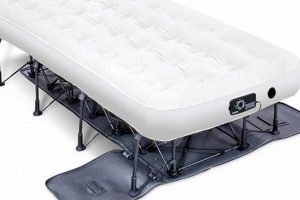
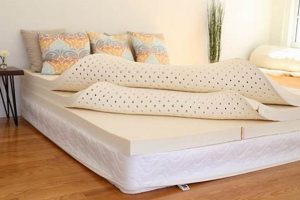
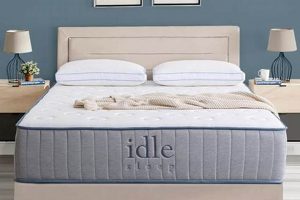
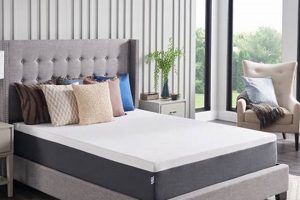
![Top-Rated: Best Foam Mattress for Camping - [Year] Guide Organic & Natural Mattress Buyer’s Guide: Non-Toxic Sleep Solutions Top-Rated: Best Foam Mattress for Camping - [Year] Guide | Organic & Natural Mattress Buyer’s Guide: Non-Toxic Sleep Solutions](https://mattressworldpa.com/wp-content/uploads/2025/07/th-7661-300x200.jpg)
